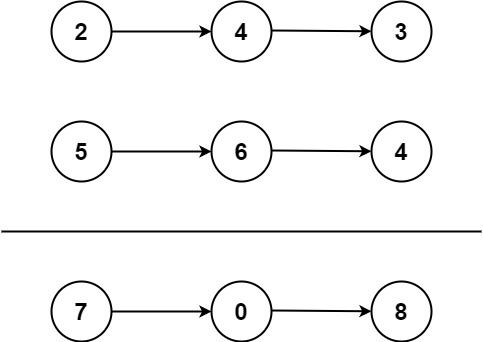Add Two Numbers
 Edward Anil Joseph
Edward Anil Joseph
You are given two non-empty linked lists representing two non-negative integers. The digits are stored in reverse order, and each of their nodes contains a single digit. Add the two numbers and return the sum as a linked list.
You may assume the two numbers do not contain any leading zero, except the number 0 itself.
Example 1:

Input: l1 = [2,4,3], l2 = [5,6,4]
Output: [7,0,8]
Explanation: 342 + 465 = 807
Example 2:
Input: l1 = [0], l2 = [0]
Output: [0]
Example 3:
Input: l1 = [9,9,9,9,9,9,9], l2 = [9,9,9,9]
Output: [8,9,9,9,0,0,0,1]
Constraints:
The number of nodes in each linked list is in the range
[1, 100].0 <= Node.val <= 9It is guaranteed that the list represents a number that does not have leading zeros.
Hint
Approach : Elementary Math
Intuition
Keep track of the carry using a variable and simulate digits-by-digits sum starting from the head of list, which contains the least-significant digit.
Figure 1. Visualization of the addition of two numbers: 342+465=807342 + 465 = 807342+465=807.
Each node contains a single digit and the digits are stored in reverse order.
Algorithm
Just like how you would sum two numbers on a piece of paper, we begin by summing the least-significant digits, which is the head of l1l1l1 and l2l2l2. Since each digit is in the range of 0…90 \ldots 90…9, summing two digits may "overflow". For example 5+7=125 + 7 = 125+7=12. In this case, we set the current digit to 222 and bring over the carry=1carry = 1carry\=1 to the next iteration. carrycarrycarry must be either 000 or 111 because the largest possible sum of two digits (including the carry) is 9+9+1=199 + 9 + 1 = 199+9+1=19.
The pseudocode is as following:
Initialize current node to dummy head of the returning list.
Initialize carry to 000.
Loop through lists l1l1l1 and l2l2l2 until you reach both ends and carry is 000.
Set xxx to node l1l1l1's value. If l1l1l1 has reached the end of l1l1l1, set to 000.
Set yyy to node l2l2l2's value. If l2l2l2 has reached the end of l2l2l2, set to 000.
Set sum=x+y+carrysum = x + y + carrysum\=x+y+carry.
Update carry=sum/10carry = sum / 10carry\=sum/10.
Create a new node with the digit value of (sum mod 10)(sum \bmod 10)(summod10) and set it to current node's next, then advance current node to next.
Advance both l1l1l1 and l2l2l2.
Return dummy head's next node.
Note that we use a dummy head to simplify the code. Without a dummy head, you would have to write extra conditional statements to initialize the head's value.
Take extra caution of the following cases:
| Test case | Explanation |
| l1=[0,1]l1=[0,1]l1=[0,1] |
l2=[0,1,2]l2=[0,1,2]l2=[0,1,2] | When one list is longer than the other. |
| l1=[]l1=[]l1=[]
l2=[0,1]l2=[0,1]l2=[0,1] | When one list is null, which means an empty list. |
| l1=[9,9]l1=[9,9]l1=[9,9]
l2=[1]l2=[1]l2=[1] | The sum could have an extra carry of one at the end, which is easy to forget. |
But the solution I had submitted did not use this approach.
Solution
using System.Numerics;
public class Solution {
public ListNode AddTwoNumbers(ListNode l1, ListNode l2) {
BigInteger intA = GetWholeNumber(l1);
BigInteger intB = GetWholeNumber(l2);
BigInteger intC = intA + intB;
ListNode l3 = ConvertToListNode(intC);
return l3;
}
//Get the whole reversed number from the list node
public BigInteger GetWholeNumber(ListNode currentNode)
{
if (currentNode == null) {
return 0; // Handle empty list case
}
string strNumber = "";
while (currentNode != null) {
strNumber += currentNode.val.ToString(); // Correct concatenation
currentNode = currentNode.next;
}
string reversedStr = string.Concat(strNumber.Reverse()); // Efficient reversal
return BigInteger.Parse(reversedStr);
}
//Convert the number into listnode
public ListNode ConvertToListNode(BigInteger number) {
string numString = number.ToString(); // Convert to string
string reversedString = string.Concat(numString.Reverse());
ListNode head = null;
ListNode currentNode = null;
foreach (char digitChar in reversedString) {
int digitValue = int.Parse(digitChar.ToString());
ListNode newNode = new ListNode(digitValue);
if (head == null) {
head = newNode;
currentNode = head;
} else {
currentNode.next = newNode;
currentNode = newNode;
}
}
return head; // Return the head of the linked list
}
}
Explanation
The two lists were converted to numbers and reversed using the function, "GetWholeNumber".
Then the two numbers are added and the new number is reversed and then converted to a List using the function, "ConvertToListNode".
The code is pretty much straight forward. Though it is not the best and elegant solution, the result was pretty much impressive.

Subscribe to my newsletter
Read articles from Edward Anil Joseph directly inside your inbox. Subscribe to the newsletter, and don't miss out.
Written by
